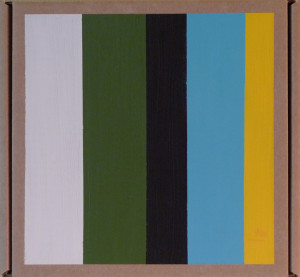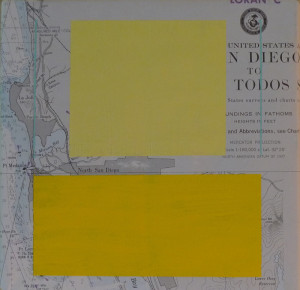Ask Laura Bacon, collections assistant and art installer for public and museum displays in the Phoenix metropolitan area, about artists she knows with an eco-hue, and she will rattle off a list of standouts in the field, as recycling and reusing is a huge trend in the art world right now.

Cardboard is also a nice material to paint on,” says Luft. Here, a thrown-out blackberry pie box provides inspiration for a new medium upon which to paint
“I’ve heard of some art organizations declining an artist’s work because it is not made of recycled or reused materials.”
“Being green is instilled in our culture, beyond just choosing artists with ‘green’ work. The organizations I work for find a variety of ways to either recycle or donate the materials used in installations,” says Bacon.
In addition to recycling materials from an installation, upcycling is a popular way to incorporate reusable materials into artists’ work.
What is upcycling, you ask? According to Cradle to Cradle: Remaking the Way We Make Things by William McDonough and Michael Braungart, upcycling is the practice of taking something that is disposable and transforming it into something of greater use and value.
A glorified form of reuse, if you will.
To some, it is an important distinction – upcycling is not recycling. Recycling, as we all know, is the process whereby materials are diverted from the landfill and broken down into their fundamental parts to be rebuilt through industrial processes into another plastic water bottle, another plastic bag, recycled cardboard, etc.
Upcycling, however, takes a material as-is and then utilizes it in a new form or medium, sometimes in a capacity starkly different from its original intention.
For example, artist Cameron Luft of Orcas Island off the coast of Washington state says his ten-year stint working at his family’s sanitation business as the recycling coordinator opened his eyes to the treasures people threw away, and inspired him to incorporate these materials into his artwork.
“Some of my favorite finds were discarded marine navigational maps that I used to paint on instead of canvas,” says Luft.
Luft also utilizes discarded paints and spray paints for use in coloring and surfaces. He says reincorporating paint into his work is especially rewarding because it is a hazardous material being diverted from the landfill.
Discarded clothing rounds out the upcycled mediums of choice for Luft. “Old clothing provides a nice material to paint on. It stretches like a canvas, but, depending on the material, can have a nice texture from the stitching as well as interesting colors form the dyed fabric.”
Upcycled art breathes new life into materials otherwise destined for a premature landfill grave.
Some art studios are even promoting exclusively upcycled shows, where the qualifying factor for entry is that pieces must fully incorporate trash or recycled materials. For example, Bragg’s Pie Factory – an art gallery in the historic and increasingly popular Roosevelt Arts District in downtown Phoenix – is hosting its 2nd Annual Trashy Sculpture Show this coming fall.

One person’s trash is another person’s treasure. Here, Luft uses a map in-lieu of brand-new canvas
Shows such as these not only help encourage artists to reuse materials, but they can help raise awareness and change perspectives on the possible new uses for materials thought useful only to a landfill.
Similarly, the upcycling, recycling and reuse trend in the art world can convey messages and themes on the nature and habits of a highly consumption-based society.
Austin-based contemporary artist Virginia Fleck incorporates green themes and reusable materials into her work.
According to Fleck’s website, her choice of media is plastic bags. By using plastic bags in her public art installations, she explores and analyzes the activity of consumerism as a spiritual encounter.
Crafting mandalas – non-religious tools for meditation typically composed of highly decorative, symmetrical patterns – she collages together “pieces of detritus from a consumerist society in a way that exposes the efforts of advertisers to influence the masses. The resulting works, each crafted from thousands of pieces of used plastic bags imprinted with familiar logos and slogans can be both humorous and unnerving,” according to her website.
Laura Bacon assisted Fleck in the installation of her work at a recent arts festival. After the show was over, disassembly included separating the materials into those to be recycled and those to be reused. “It was a huge installation, and we only had two bags of trash at the end of it all. Most of the trash came from feeding the crew,” Bacon says.
Not only does the reuse of materials reduce the material impact of such public art installations, but it can also provide other artists the opportunity to explore different mediums, textures and themes for their work.
According to Bacon, a local Phoenix artist utilized the non-recyclable netting that held together Fleck’s installation as the base layer for work exploring themes of identity and sexuality, demonstrating that the reuse of materials does not necessitate solely green-centric themes in artists’ work.
And, for a sometimes cash-strapped artist in a tough economy, Bacon suggests, “Going green is a great economic option. Reusing or choosing recycled materials quickly arises as a cost saving measure.”
Article by Jennifer Berry, Earth911
Article by Jennifer Berry, Earth911

No comments:
Post a Comment